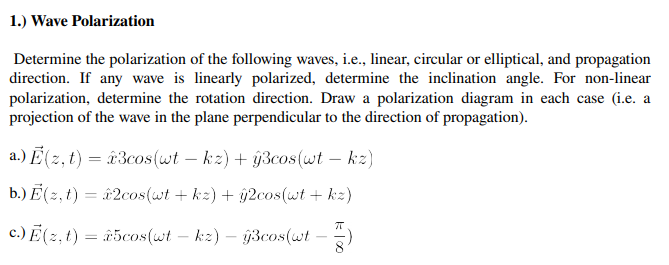1.) Wave Polarization Determine the polarization of the following waves, i.e., linear, circular or elliptical, and propagation direction. If any wave is linearly polarized, determine the inclination angle. For non-linear polarization, determine the rotation direction. Draw a polarization diagram in each case (i.e. a projection of the wave in the plane perpendicular to the direction of propagation). a.) Ē(z, t) = £3cos(wt – kz) + ÿ3cos(wt – kz) b.) Ē(2, t) = &2cos(wt + k2) + ŷ2cos(wt + kz) c.) E (z, t) = r5cos(wt – kz) – ý3cos(wt – )
1.) Wave Polarization Determine the polarization of the following waves, i.e., linear, circular or elliptical, and propagation direction. If any wave is linearly polarized, determine the inclination angle. For non-linear polarization, determine the rotation direction. Draw a polarization diagram in each case (i.e. a projection of the wave in the plane perpendicular to the direction of propagation). a.) Ē(z, t) = £3cos(wt – kz) + ÿ3cos(wt – kz) b.) Ē(2, t) = &2cos(wt + k2) + ŷ2cos(wt + kz) c.) E (z, t) = r5cos(wt – kz) – ý3cos(wt – )
Related questions
Question
Please solve ASAP

Transcribed Image Text:1.) Wave Polarization
Determine the polarization of the following waves, i.e., linear, circular or elliptical, and propagation
direction. If any wave is linearly polarized, determine the inclination angle. For non-linear
polarization, determine the rotation direction. Draw a polarization diagram in each case (i.e. a
projection of the wave in the plane perpendicular to the direction of propagation).
a.) E(2, t) = â 3cos(wt – kz) + ý3cos(wt – kz)
b.) E ( 2, t) = &2cos(wt + kz) + ŷ2cos(wt + kz)
c.) E (2, t) = r5cos(wt – kz) – ĝ3cos(wt – 2)
Expert Solution
This question has been solved!
Explore an expertly crafted, step-by-step solution for a thorough understanding of key concepts.
This is a popular solution!
Trending now
This is a popular solution!
Step by step
Solved in 4 steps with 4 images
